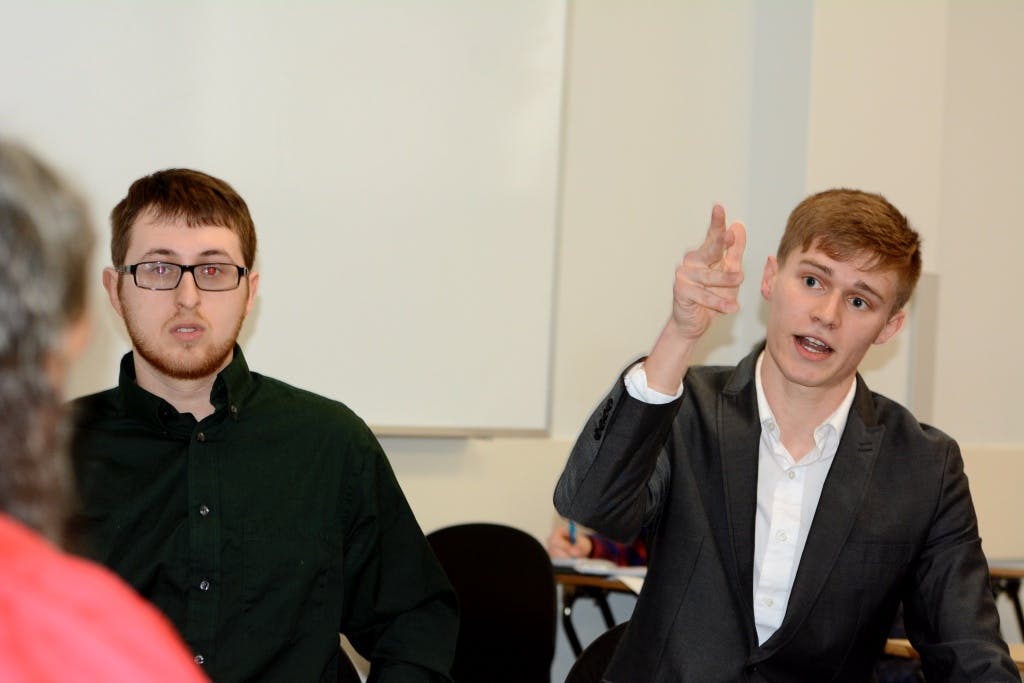AT&T's Acquisition of Time Warner Approved with Caveat
AT&T’s proposed acquisition of Time Warner Inc. played out in a mock trial setting, Wednesday (Feb. 21) at Wilmington College, that pitted the government against the corporate giants complete with presentations of a case, defense, final statements and a verdict by a judge.
PICTURED: Jason Altmayer, portraying a government attorney, makes a point before the judge as his legal partner, Christopher Howard, looks on in an economics class mock trial featuring the AT&T/Time Warner merger.
Presiding over the hearing was Dr. Steve Szeghi, professor of economics, who donned a magistrate’s robe for the proceedings. His class in Advanced Theoretical Economics has been role-playing in cases involving such real and imagined corporate mergers as Ford and General Motors, Coca-Cola and Pepsi, and AT&T and Time Warner.
Unlike the imagined horizontal mergers featuring the motor vehicle and soft drink companies, AT&T’s acquisition of Time Warner mirrors a scenario being played out in real courts complete with the Trump White House’s criticism of the deal.
In Szeghi’s courtroom, the government, which was represented by anti-trust legal counselors Jason Altmayer and Christopher Howard, presented a case that the merger should not be allowed largely on the basis that a behemoth of a media corporation — which would be known as AT&T and T — could potentially monopolize an unduly large portion of the media industry.
Indeed, the government said such major entertainment entities, as the powerful quartet known as FANG (Facebook, Amazon, Netflix and Google), could be adversely affected should the merged entity attempt to slow down their Internet speeds or otherwise purposely limit FANG users’ access. Indeed, those media flow through AT&T and Time Warner’s Internet pipelines.
The defense, represented by Tyler Tarnowski and Tyler McDaniel, framed the acquisition as a vertical merger between two corporations that operate at separate stages in the industry’s supply chain. — in essence, they are two different companies operating in two different industries. They stated the proposed AT&T and T has no intention of such transmission interference, to which the government pointed out previous fraudulent acts committed by the companies.
This appeared to score points with the judge.
Ultimately, the idea of net neutrality played a pivotal role in the case, as the government stated the recent loss of net neutrality — the now diminished mandate that Internet providers treat all data the same — creates an unequal playing field that allows those who control the delivery pipelines to, should they desire, negatively manipulate competitors’ transmission of services.
Following final arguments, the judge excused the plaintiff and defense attorneys and discussed the case with the class before presenting his ruling.
“The judge thought the whole issue of net neutrality is huge in this proposed merger,” Szeghi said in presenting the verdict. “The government made an extremely strong case to disallow this merger, extremely compelling. However, the judge approves the merger with the caveat for a legally binding agreement in which this new corporation, AT&T and T, would agree to abide by net neutrality.”
He directed the defense lawyers to provide documentation ensuring that their corporate leadership agrees it will adhere to the net neutrality qualification before he declares the case closed.

Economics Class Holds Mock Trial on Controversial Merger
Business Administration